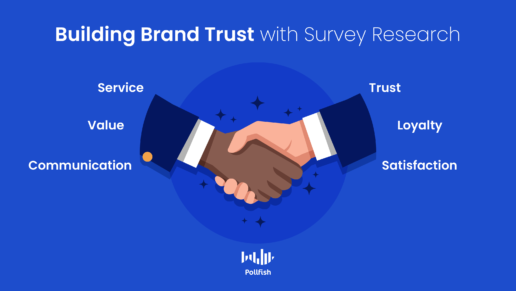How to Build Brand Trust With Surveys
How to Build Brand Trust With Surveys

Businesses must reach a sense of brand trust, as it reflects customers’ expectations of a brand being able to fulfill its promises about its products, services and experiences.
As such, all businesses must work towards securing a strong sense of brand trust, as no business is immune to customers who don’t trust it.
Although large companies carry high brand equity and therefore seem to be at an advantage when it comes to brand trust, 76% of consumers trust small businesses more than large.
However, this doesn’t mean that small companies automatically have more brand trust and can reap all of its benefits. All brands have to establish this concept for themselves, as lacking it has dire consequences. 81% of customers say that they will only buy from a brand they trust, which leaves the brands that they don’t trust at a major disadvantage, one that will undoubtedly harm their revenue.
This article explores the notion of brand trust, its importance, benefits, how to achieve it through five common ways and how survey research helps brands attain this consumer confidence.
Understanding Brand Trust
Brand trust gauges how much confidence a target market has in a business. Customers exhibit their trust in a brand as a kind of willingness to rely on the ability of a brand to perform its key functions and the other promises a brand makes, whether they are in the form of advertisements, social media, their website, their marketing content or otherwise.
Brand trust typically arises after customers evaluate companies' offerings. However, there is much more involved in trust-building. Customers, therefore, don't merely assess offers; rather, they weigh a company’s promises against their products, services and experiences.
This involves CX (customer experience), the total of all the feelings that customers undergo throughout their customer buying journey.
The concept of brand trust is rooted in a brand’s reputation, as such, it carries all the important aspects of maintaining a good reputation with customers and the general public. It should thus come as no surprise that brands with poor reputations struggle, while brands with good reputations strive.
It may take longer for brands to establish a healthy level of brand trust when it is new, virtually unknown or untested, or in times of reputational crises. As for the latter, it can emerge during scandals, significant bad reviews, poor social mentions and more.
The Importance of Brand Trust
This business concept is important for various reasons, most prominently because the way consumers, especially a target market, feels about business matters. Trust is important, as it is one of the most positive feelings that customers can have towards a brand.
Brand trust brings value to a target market. While some situations may prompt customers to buy from a brand they don’t trust, these are nothing but one-off instances of need and lack of other options. Trust, on the other hand, fosters consumer loyalty, the bedrock of repeat sales, aka customer retention. It is no wonder that an increase in brand trust correlates with a higher customer retention rate.
As such, when brands build trust, customers reward them with ongoing loyalty, a long-lasting relationship in which customers don’t merely buy from the same brand, but choose it over competitors time and again. In this way, the continuous support brands attain with brand trust yields a higher CLV, or customer lifetime value.
CLV denotes the total monetary value a customer will bring to a business during their relationship with the business across their lifetime. Given that brand trust incites customers to continuously purchase from the same brand, it positively ties in with customers’ CLV. Thus, the longer relationships present in retention spur more monetarily valuable customers.
Aside from valuable customers, brand trust is crucial to a company's livelihood, as it softens the blow of a reputational crisis. This is because customers who are loyal will continue to engage and purchase with a company they trust, as opposed to a company they have little or no trust in. As such, brand trust serves as a kind of security blanket, enabling companies to take more risks.
Brand trust also forges brand advocacy. When a happy customer becomes a recurring customer, they tend to speak out about their positive CX, therefore becoming a customer advocate. Customer advocates help brands obtain brand awareness and augment their brand visibility, reputation and overall branding efforts.
They do this by spreading rave mentions about the brand they trust on social media, forums, review sites, brand websites’ comment and review sections, along with via word of mouth. This is tremendously important for a business, as customer advocates do many of the things that salaried marketing and PR employees do, but for free.
Finally, when a brand reaches high levels of brand trust, it is not only setting itself up for a better reputation and higher sales, but it is growing in its potential to be a key player in the cultural trends of an industry. Sometimes, this potential may carry over to greater cultural relevance, such as being a household name of a product that represents an entire country.
The Benefits of Brand Trust

There are several benefits to brand trust, which complement its importance, as laid out above. These benefits also bring new ideas that support the need to establish and maintain brand trust. The following lists the key benefits of securing a strong sense of brand trust within your business:
- Brand trust drives new business, making customer acquisition more feasible.
- It makes consumers more receptive to marketing campaigns.
- It fosters connections with consumers and drives loyalty.
- It allows brands to innovate more, since consumers trust what they.
- It makes those who write or speak negatively about a company lose credibility.
- It helps brands achieve cultural relevance when strong enough.
- Key benefits such as brand loyalty, advocacy and goodwill allow businesses to overcome various challenges and obstacles.
10 Ways to Build Brand Trust
There is far more to building brand trust than simply executing a strong product experience. Consumers have growing concerns about the customer experience (CX) that brands promise, along with other promises brands make in their marketing messages, such as their impact on society.
As such, businesses need to pay attention to other key facets to work towards strengthening, solidifying, and in some cases, establishing brand trust. The following lists include 10 pieces of advice for brands to build trust among their target market and the general public.
- Create quality products and services.
- Establish optimal omnichannel CX, including digital experience, in-person, over the phone, etc.
- Charges reasonable prices.
- Offer promotions, sales and customer rewards programs.
- Include a generous return policy.
- Treat customers well, whether on a chat, on phone support, etc.
- Handle customer service issues quickly.
- Keep up your end of promises.
- Establish clear communication with customers.
- Create consistent content; content is king for many reasons.
How to Forge Brand Trust Through Surveys
Survey research is a proven method of accurately measuring consumer sentiment through customer feedback — when used with the correct online survey platform, that is. Surveys allow businesses to probe as deeply as they wish into virtually any business matter, from product satisfaction to customer effort. When it comes to building trust, surveys allow market researchers and business owners to understand their target market’s needs, desires, expectations and aversions, which essentially tells them all they need to know to build trust.
Researchers can set up surveys with questions that are as granular as they need, allowing them to zero in on a topic, so that they can identify and apply the proper course of action, whether that entails correcting something, creating a new product feature, changing an existing experience and much more.
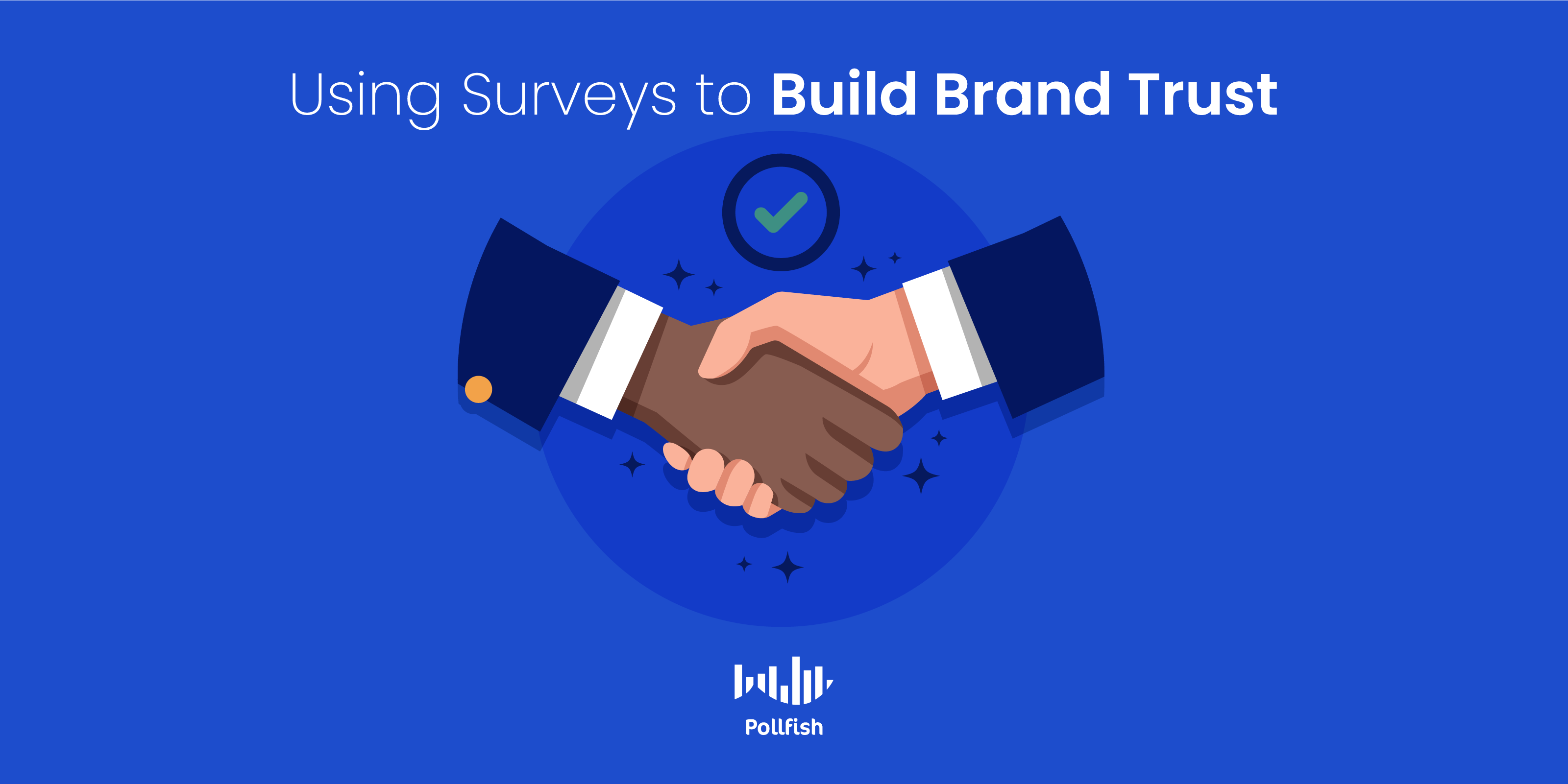
Additionally, researchers can make their sampling pool as granular as possible in the screening section of a survey. In this section, researchers can filter respondents as precisely as they need, setting eligibility requirements on demographics, psychographics, device used and more.
Researchers can even set restrictions based on how respondents answer additional screening questions, permitting only those who answer in a certain way to take part in the survey. That way, only the qualified respondents will be able to take the survey.
By providing precise information and quality data, surveys enable businesses to extract only the information that they need to build brand trust. Businesses can deploy as many surveys as they deem necessary. By iterating surveys, brands can gather as many perspectives as possible from their target market, paving the way for new ideas to build and improve trust and maintain statistical accuracy in the findings.
Heightening Your Brand for the Long Term
Brand trust is critical for the survival of any business. Whether you seek to increase sales or customer loyalty, remain relevant or simply to stay afloat, you need to build brand trust for your business.
When your brand consistently delivers on quality, reliability and credibility, it will yield significant benefits, as customers will go to your brand first and repeatedly when they look for products and services in your niche.
To build brand trust, you must understand your customers as precisely as possible, cater to their needs and form marketing campaigns and promises to begin with. Survey research has transformed businesses' access to consumers, allowing them to reach a wide swath of their target market and extract their feedback and other necessary customer data.
However, not all online survey platforms are built the same, therefore, they don’t all offer the same capabilities and reap the same benefits. To gain the most quality customer data, businesses must use a strong online survey platform, the kind that offers random device engagement (RDE) sampling to engage respondents in their natural digital environments, uses
You should also use a platform that offers advanced skip logic to route respondents to relevant follow-up questions, one that implements quality data checks via artificial intelligence and machine learning and much more.
When an online survey platform offers these capabilities, businesses gain the most relevant and high-quality consumer data, the kind that allows them to accurately understand their customers’ preferences, expectations and virtually all else. In turn, it allows businesses to feasibly build and improve their brand trust.
Diving into the Concept Testing Survey for Marketing and Product Development
Diving into the Concept Testing Survey for Marketing and Product Development

Using a concept testing survey to inform marketing and product development is like giving your target audience a seat at the table.
Concept testing refers to the market research practice you should perform early in the marketing and product development process. It helps you find out how your products will resonate with your customers.
While traditional market research requires respondents to choose from pre-existing criteria, concept testing requires them to provide unique feedback.
With a concept testing survey, your business can assure that it is putting out products that your customers will be fond of. Use this article as a guide to get started.
Defining a Concept Test Survey
 A concept test is a research method wherein your business accrues customer feedback about a new product before it launches.
A concept test is a research method wherein your business accrues customer feedback about a new product before it launches.
A concept test survey, as its name implies, is a survey that utilizes a concept test.
Surveys are tools with questionnaires designed to elicit unique responses from your target audience in reference to your business’s new product or product feature idea.
Concept surveys differ from other surveys, in that they help your business to evaluate concepts before they go to market to understand how your customers will react. The concepts include anything that can be tested for marketing purposes, such as an advertisement, a slogan, imagery, emails, a particular service, and more.
Surveys act as a safety net for new products, helping your company predict whether they will succeed or fail.
Why Your Business Needs a Concept Testing Survey
A concept testing survey is important, as it provides insight into how products will be received. With proper concept testing, your business can avoid investing in concepts that won’t succeed (saving you a lot of money). On the flip side, you can increase investment in concepts where testing predicts success.
Basically, a good concept testing survey system can help your business save money and resources, while earning money at the same time.
Concept Testing Survey Methods
The first step to a successful concept test is choosing the right method. Here are the most common methods:
- Single Concept Evaluation (Monadic testing) – a full evaluation is given on one concept. Participants are made aware of features and prompted to discuss whether they approve or disapprove as their survey response.
- Multiple Concept Evaluation (Sequential Monadic) – full evaluations are completed for multiple concepts.
- Concept Selection (Comparative) – Respondents choose their most preferred concept.
- Concept Selection and Evaluation (Comparative Monadic) – Respondents choose their most preferred concept and provide a full evaluation of that concept.
Each product testing method has its advantages and setbacks. As a business, you should choose the one that best fits your specific needs, based on the concepts you want to test and the results you seek.
You should use survey software to ask questions about your products. Survey software is also helpful in pushing your surveys to your target audience.
The survey questions should include the following:
- What do you like most about this product?
- What do you like least about this product?
- How likely is it that you’d buy this product?
You can use more specific questions, just make sure they are relevant to your products for the most useful feedback.
Concept Testing Survey Use Cases
Concept testing can be used at almost every stage of the marketing and product development process. Here are some common use cases:
Logo Testing
A concept testing survey is an asset when conducting branding market research. For example, logo testing is a great way to see how your customers will perceive your business’s new logo.
You can use concept testing surveys to identify what your logo communicates to customers. Ultimately, logo testing is the best way to discover the logo that best embodies your brand.
Website Design
Concept testing surveys also come in handy when you redesign a site or launch a new one. Through concept testing, your brand can see how its design concepts will be perceived by a selection of people who will one day interact with your website. This gives you an inside look at how the sample of your target population thinks, guiding their design decisions for the best possible outcome.
Ads, Landing Pages, and Conversions
Split-testing is a popular way to test headers, images, and other website content to see which resonates most with an audience. Also called A/B testing, split testing is a random experiment where two versions of a piece of content are shown to your target audience. Whether customers see version A or version B occurs completely at random.
Through analytics, this method helps you identify which ad, landing page, or other pieces of content is most compelling for their audience. You can see which customers convert.
Concept testing takes this method to the next level by allowing your business to hear from your audience directly. As such, you won’t simply obtain numbers, as concept testing gives you qualitative feedback about the “why” behind the numbers.
Beyond just validating the numbers, this inside look into the minds of your audience could lead businesses in new directions and even spark new ideas.
Pricing and Upgrades
Concept testing is also a great way to project how upgrading products and services or altering your pricing system will be perceived. The best way to do this is by using migration path tests to gauge your customers’ initial thoughts and see what features and benefits they crave. Migration path tests compare migrated data with original data. Your business can create upgrade tests to predict how the new product will affect your sales.
Name Testing
Deciding on a name can be rather difficult when forming a new company or creating a new product. The impact a name has on overall success can be paralyzing, especially since it’s usually composed of only a few words.
Those few words have to convey what your business offers, its benefits, and how your brand should make customers feel to your audience.
By using concept testing surveys, your business will be able to test potential names and request evaluations on what your customers believe the names convey. This feedback will guide you on the correct track to choosing the perfect name for your business.
Price Testing
Have you ever considered how your customers feel about the value of your products? You can use concept testing to find out whether or not your customers are satisfied. You can also use price testing when you alter the prices of your products. This is an effective way to find out how your customers will receive any new redesigns or product innovations.
Package Testing
Packaging matters more than many a business may think. Do you know what your customers think about your current packaging? Using a concept testing survey for package testing is a strong method to discover if your customers are impressed or irritated by your business’s packaging.
Messaging
When your business is unsure about how its target audience will perceive your messaging, you can apply a concept testing survey to learn more. This shows them if your messaging resonates with your audience. As such, you can gather how it communicates the value of what you offer. You can use the insights from concept testing to create a style guide that informs future messaging.
Product and Concept Development
This might be the most obvious use case of them all. A concept testing survey is an essential part of transferring products and concepts from ideas to reality. Concept testing can reveal missing product features as well as features that offer no benefit and can be removed entirely. Your business can discover what its customers think about your new product’s quality and usability. Overall, product concept and usability tests are the ultimate way to make sure every product your business releases is up to par.
Step Up Your Product Development with Concept Testing Surveys

All businesses should use a concept testing survey at virtually any level of the marketing and product development process. Listening to direct customer feedback gives you an edge over your competition by equipping your business with key information about the specific wants, needs, aversions, and sentiments of your target audience.
Frequently asked questions
What is a concept testing survey?
A concept testing survey is a survey that uses a concept test. The survey asks questions that trigger unique responses from your target audience in response to a new product or concept. Concept testing surveys are unique surveys because they help businesses predict customer reactions before products are released.
Why should market researchers use a concept testing survey?
Market researchers and business owners should use a concept testing survey, as it informs product marketing decisions by predicting which concepts and products will succeed (and which will fail). It’s a way to ensure you’re putting out products your customers will love.
How do you to use split-testing in a concept testing survey?
Split-testing is a common method of testing headers, images and other website content to see what version customers respond to best. It helps brands optimize their website content so that it resonates with their audience. Concept testing surveys that use split testing give similar feedback, but they let you hear from your audience directly.
What are migration path tests used for in concept testing surveys?
Migration path tests compare migrated data with original data to gauge customers’ initial thoughts and to find out what features and benefits they’d like to see. They are useful in concept testing surveys meant to project how pricing changes and product upgrades will be received.
How do you use split-testing in a concept testing survey?
Split-testing is a common method of testing headers, images and other website content to see what version customers respond to best. It helps brands optimize their website content so that it resonates with their audience. Concept testing surveys that use split testing give similar feedback, but they let you hear from your audience directly.
How Relentless Quality in Market Research Perfects the Strategic Planning Process
How Relentless Quality in Market Research Perfects the Strategic Planning Process

Surviving in business depends on a well-established strategic planning process — and not just for new businesses. This ensures that a business establishes its priorities and correctly focuses its efforts and resources in order to obtain them.
Despite the importance of this process, up to 67% of strategic planning fails.
You can build an effective strategic planning process with market research, but you’ll need to use the proper market research tool.
That’s because in the demanding world of business today, market research tools must provide relentless quality in order to sustain a strategic plan.
This article explains the strategic planning process and how a market research platform that provides relentless quality can support this effort.
Understanding the Strategic Planning Process
This process involves all the activities that your business performs as part of strategic planning, the organizational management activity used to identify priorities, set goals, map out a direction, produce strategies, allocate resources, and make decisions to accomplish the goals.
This process plans the fundamental course that your business should take, along with its actions, while layings out what your business seeks to do, who it will serve, and why it will do so. It is built with a focus on the long-term.
In the strategic planning process, your business must cover as many bases surrounding itself as possible, including where it currently stands, where it is going, where it seeks to go, and what it’s striving to achieve. Additionally, the strategic plan must include all the actions required to accomplish its goals based on this evaluation.
The strategic planning process also includes measuring the effect of its activities and whether your business has achieved the kind of results it sought., It is therefore an exhaustive process that involves strategy, exchanging ideas, testing and implementation.
Essentially, the strategic planning process centers on a catalog of steps that managers must follow to form and implement a strategy within a company. This process aligns the entire company around its main goals and how to execute them. As such, it is also meant to create transparency, so that no employees are left wondering about the objectives of a company and how to incorporate them into their daily work.
The Importance of a Well-Executed Strategic Planning Process

It is critical to establish a solid strategic planning process for a number of reasons. Without clearly established goals and plans, your business would be navigating in the completely uncharted and unaided territory.
As for the process itself, your business must understand the steps it will need to take to tackle its goals, especially since many of them are mid-to-long-term goals. The following lists the various benefits of a well-executed strategic planning process:
- It sets a clear set of goals and an honest assessment of an organization’s strengths and weaknesses.
- It reveals what is most important, relevant, and actionable in business, removing the guesswork.
- It offers plans on how to achieve its goals, with different ideas that businesses can smartly put to the test.
- It helps companies understand how they can improve their performance.
- It shows businesses where their biggest challenges lie, whether it is in your business itself or external factors (laws, changing trends, customer behaviors, etc).
- It prevents businesses from performing tasks that will yield little to no growth or benefits.
- It enables businesses to respond to a change or an issue with preparation, lowering stress and the difficulty of handling the unknown.
- It fosters and upgrades the technical abilities of your workforce or product.
- It aligns employees and shareholders with business objectives and visions.
- It determines KPIs so that businesses can track progress based on data.
When to Use the Strategic Planning Process
Strategic planning is an ongoing activity, therefore its process should not be applied just once. Although mainly used by new companies and startups, strategic planning should be involved at various stages, especially those that are bent on making change.
As for scheduling the process, this will vary based on the needs and experiences of your business and its external settings, such as its niche, target market, or competitors.
The strategic planning process should be regularly carried out in a business that operates in a frequently changing industry, such as the SaaS industry, for example. In this case, this kind of process should take place 1-2 times a year.
If your business has existed for a long time and is in a slow-moving market, it can carry out a lesser frequency of one strategic planning process a year. This should involve updating in which only certain parts of the process.
Aside from new businesses, all businesses should perform strategic planning when taking on any new venture, whether it is an acquisition, a new department, product, or branding change.
Businesses that are in an unstable or semi-stable marketplace should conduct the strategic planning process at least once a year in preparation for the coming fiscal year. By doing so, they can identify the organizational goals to accomplish in the coming fiscal year, along with finding the resources to obtain the goals.
In this way, this process is a must for budget planning. However, businesses will not need to complete every step of the process each year, as the full strategic planning process should be conducted at least once every three years. As mentioned previously, it should be conducted every year when businesses or their external environments undergo a massive change.
Although longtime businesses in stable marketplaces don’t need to conduct this process yearly, they must review it once a year to determine any new action items and to determine whether anything should be removed.
How Market Research Supports the Strategic Planning Process
Market research is invaluable to the strategic planning process, as it provides a stable foundation for virtually every step of the process.
This form of research provides insights on your business’s target market and industry at large, the kind of crucial data that supports a vast array of decision-making.
That is because creating objectives and planning activities around them based on intuition is dangerous and costly. Unfortunately, many businesses do not pay enough attention to their market research data, or any sort of data, as over half of the data businesses obtain goes unused.
This is a major misstep as market research offers relevant information on the heart of your business: its consumer base. A strong market research tool can help your business reap the most updated data on its target market, along with specific market segments.
In this way, using a primary source of research is superior to conducting secondary research alone, as secondary research may not be fully updated, relevant to your business’s specific needs, or involve using questions that a particular business needs to address.
Market research provides the key insights that a strategic planning process needs, as it sets concrete objectives and lays out concrete processes, all of which require time and resources. By gathering and analyzing market research, your business can gain a competitive advantage, one that yields 10 percent in sales growth and higher margins.
A market research survey in particular is a potent way of extracting the kinds of insights that set a strategic planning process in motion. Surveys are versatile and can take various forms, from customer satisfaction surveys like the NPS to employee feedback surveys, to B2B surveys, and many more.
They are devised to help your business understand a number of issues, such as product satisfaction, product needs, opinions, aversions, user experience, and much more. You can create them with any sort of questions, depending on the market research platform they use.
In order to create a strong strategic planning process, businesses should turn to a market research tool that offers relentless quality.
How a Platform Offering Relentless Quality Perfects the Strategic Planning Process

Obtaining a market research platform that is built on relentless quality is difficult to come by. While this may be a tall order, given that there are so many tools marketed in this way(but not verbatim), only a few deliver on this promise.
The Pollfish market research tool, on the other hand, delivers relentless quality, the kind designed to provide a 360-degree assessment of all the factors involved in a strategic planning process.
Whether your business needs to determine its specific market segments through market segmentation or weed out survey fraud and faulty responses with artificial intelligence, Pollfish offers both and much more.
It also uses a viable sampling method to gain timely responses in a randomized way to limit survey bias. This method is known as random device engagement (RDE) and it is extremely effective at gaining responses from a target market the natural way, by deploying surveys across a vast network of digital properties that users visit voluntarily, meaning that they are not forced to take a survey or are pre-recruited.
It helps your business gain intelligence at virtually every aspect of the business relating to its customers and employees, which helps hammer out reasonable objectives and a market research budget for a strategic planning process.
Additionally, businesses can use the Pollfish platform for the following aspects of their strategic planning process:
- Finding funding priorities
- Gauging customer-service satisfaction
- Discovering new customer needs that can help set off new product launches
- Identifying the backbone of strategic goals
- Discovering whether a business needs to change its branding direction
The Pollfish platform allows businesses to gain access to all of these factors and more in a friction-free way, as the platform is user-friendly; there are only three main steps to make your own survey.
The platform uses quality checks to remove any below-par data, such as repetitive answers (flatlining), gibberish answers, VPN use, and more. It does so through a machine learning system that cancels out the need for manual quality checks.
It also offers 24-hour support from a dedicated team of market researcher experts. As such it is possible to perfect a strategic planning process, as long as it is done with the proper market research tool. Because the Pollfish online survey platform offers proven relentless quality, your business should look no further and use Pollfish for all their strategic planning needs.
How to Conduct a Market Trend Analysis for Sublime Market Research
How to Conduct a Market Trend Analysis for Sublime Market Research
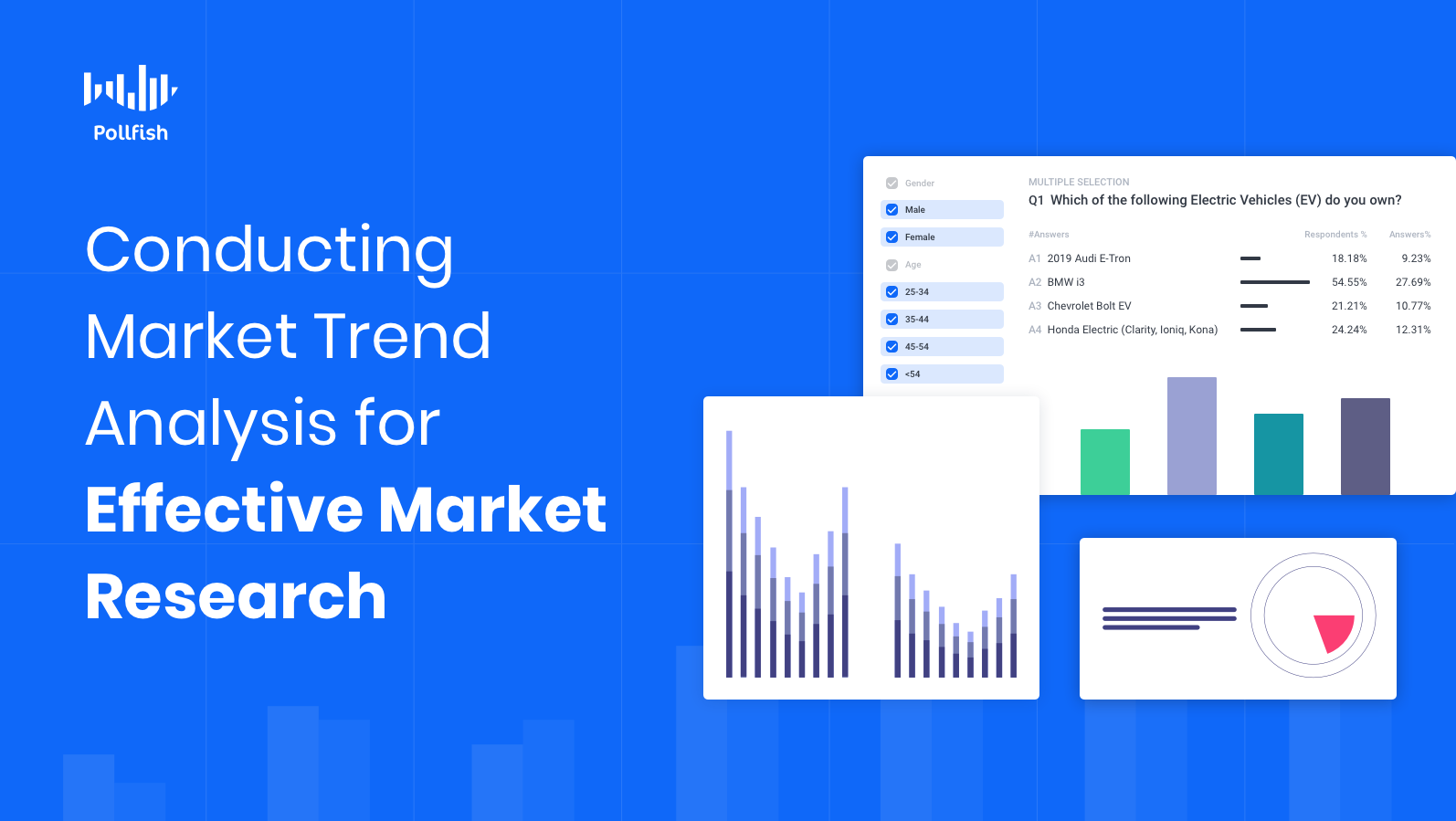
Conducting a market trend analysis is critical for a market research campaign, as it uncovers trends in both an industry and within a target market — the group of customers most likely to purchase from a company.
Market trend analysis is valuable for data-driven decision-making, as it consolidates trends extracted from data and puts them and their key aspects, such as customer behavior, for example, into perspective. In turn, this helps businesses recognize patterns and make predictions on various strategies and campaigns, along with discovering future trends.
Additionally, although trend analysis is chiefly used in the financial sector, its concept is also essential to market research, as it is used to make sense of survey data analysis, allowing researchers to understand their findings, thereby improving the market research process.
This article explores market trend analysis, why businesses must conduct it, how to conduct it for efficient market research and more.
Understanding Market Trend Analysis
A market trend analysis is a kind of trend analysis, except rather than focusing on the financial aspects of a sector or business, it refers to analyzing trends in a market or industry at large.
Specifically, a market trend analysis is a method of analysis on past and current market behavior, along with dominant patterns of the market and its consumers. This kind of analysis relies on examining statistical data and recorded market behavior over a defined period of time.
This kind of analysis covers a wide range of topics, as trends can appear within different aspects of a market.
Businesses, therefore, use this kind of analysis to extract necessary information in order to map out and support the strategic planning process and forecast future trends within customers, campaigns and other business plans.
Identifying the prominent traits of an industry and its target market, this kind of analysis acquaints businesses with key occurrences in the market, thus it is a vital practice in market research.
The Importance of Market Trend Analysis

Market trend analysis carries significant weight in market research, for a number of reasons, including the ones aforementioned.
First off, one of the greatest concerns in a business and virtually any entity is that of performance. A market trend analysis grants insights on performance, identifying areas of sufficient business performance, along with those that aren’t faring well.
Thus, it helps businesses on the decision-making front, providing insights that boost long-term strategy and helping businesses avoid future setbacks.
Given that in market research, trend analysis is used to better understand consumers, this kind of analysis provides insights into customer behavior trends, allowing businesses to cater to customers with data backing all of their decisions. This way, customers are more likely to engage with brand campaigns and make purchases.
Moreover, market trend analysis can obtain valuable insights into the overall scenario of a market. For example, a SaaS company can discover the products, services and startups within a particular niche of their industry.
Alternatively, a shoe brand can discover the latest trends in shoe designs and fashions by running various market research campaigns that capture customer sentiment, opinions, preferences and recognition of shoe brands and styles.
Market trend analysis also helps businesses gain an understanding of their market’s macro-environment, the holistic condition existing in an economy, rather than a specific sector of it.
Conducting trend analysis helps businesses find and display long-term data in summary form. The data can be used to investigate changes across different points in time and find how both customers and markets respond to them.
These variations can involve changes in demand levels in the market, allowing businesses to take appropriate action, as periods of high demand and low demand require different strategies.
What Businesses Can Learn with Trend Analysis
Businesses can gain the various insights laid out above. In terms of market research, these insights provide information about three key aspects: customer preferences, the macroeconomic environment (market’s economy at large) and changes in the industry.
With the trend analysis report, you can compare historical data and get answers to questions like:
In market trend analysis report, businesses can understand the following:
- Changes in their NPS score over a period of time
- Levels of employee engagement and turnover
- Sales fluctuations and forecasts
- Change in customer experience in the past year
There are various other market aspects that businesses can examine with this kind of analysis. In addition, businesses can plan their actions in response to long-time or emerging trends and any changes in their market. As such, trend analysis prepares businesses for the long term.
The Different Types of Market Trend Analyses

There are four main types of market trend analyses that businesses and market researchers should acquaint themselves with. The following explains the four kinds, so that businesses can aptly conduct a market trend analysis and analyze it based on the categories.
- Consumer Trend Analysis:
- This focuses on trends among a target market, its segments and customer personas.
- It involves gathering key customer data such as customer satisfaction, customer aversions, needs, opinions, preferences, customer buying behavior and more.
- This involves studying product trends in relation to customers' reception and opinions of them.
- Historical Trends Analysis:
- This is an investigation into past industry trends in a market or niche.
- It shows researchers how such trends developed, how they affect the present and how they will affect the future.
- Historical trends concern historical data, which can date back years, along with data from the near past, such as the past few days, weeks and months.
- In this kind of trend analysis, there is typically a comparison between the current market with others, such as year-by-year or period-by-period analysis.
- Seasonal and Temporal Trend Analysis:
- This is an analysis of market shifts relating to seasonal events, such as holidays, the weather, natural disasters, etc.
- Many of these are recurrent, such as the holiday season, which starts around late November and lasts through most of December. For businesses, strategizing for this season occurs many months in advance, thus the data they use tends to be historical trends analysis.
- Geographic Analysis:
- This entails studying trend changes based on geographic location.
- These analyses can include comparisons between different regional areas within a country, or on an international basis, studying trends from different countries and even continents.
- It involves conducting global market research, should the trend analysis delve into international markets.
- This analysis seeks to discover how trends develop in geographies of various sizes and places.
How to Conduct Market Trend Analysis to Excel in Market Research
There are various means to run such an analysis and businesses can complete this with a process for collecting, comparing and analyzing data.
The following explains how to conduct market trend analysis in a step-by-step process.
- Determine the trends you seek to study for your trend analysis. To do so, refer to the above section on the major different kinds of market trend analyses. You can also perform a social media and desktop versus mobile analysis, should your business require it.
- Create a focus on your trend analysis within the main topic you chose. For example, if you choose to analyze consumer trends, consider the major aspects of consumers that you ought to focus on for your study. This will differ from business to business.
- For example, you can study their reactions to your ads and marketing messages, their purchasing behaviors, their preferences, etc.
- Pinpoint your target population of study. You can also begin broadly, by targeting the entirety of your target market.
- Conduct secondary research in regards to your target market and the focus of the study.
- There are various online sources to consult, such as trade publications, news sites, sites dedicated to your niche, statistics websites, etc.
- Stay up to date with industry research and trends reports. There are various online sources offering these reports, such as IBISWorld.
- Study your competition. Observing your competitors gives you a good picture of their market positioning and how they react to an emerging trend.
- Conduct primary research around the focus of your trend analysis. There are various methods and digital tools that can be used to extract primary data. Survey research is among the strongest, as it powers its users to inquire into any topic, form and ask any question, along with distributing the survey to its intended audience.
- Find the correct online survey platform to conduct your primary trend analysis research. A strong tool is user-friendly, offers deployment on a vast network of popular websites and apps, offers global support, uses random device engagement (RDE) sampling and more.
- Analyze all of your findings by studying both primary and secondary resources. Specifically, look for patterns and repeated actions, opinions, etc.
- Based on your analysis, identify all possible trends, both minor and major. Create a document based on these findings.
- Put your analysis into action. If you are able to successfully discover trends, create a plan of action based on them. Your plan of action can include new campaigns or changes to current campaigns, changes to your strategy or changes to how you engage your topic of study, in this case, the customers.
- You ought to conduct more survey research should your analysis appear to be lacking, if it leads to further questions or if you simply need to understand your trends at a more granular level.
Powering Each Market Research and Trends Project
Conducting a market trend analysis is a crucial factor in maintaining strong market research campaigns. Aside from uncovering trends among customers, market segments and the market at large, this kind of analysis complements any market research endeavor, with key, organized data.
While there are various means of performing market trend analysis, survey research helps carry this kind of analysis, as it empowers researchers to inquire into virtually every business subject, from purchases, to buying habits, to brand recognition and much more.
As such, the proper online survey platform will unlock various trends, but businesses must choose one wisely, as they are not all built the same. A strong online survey platform will enable businesses to deploy a massive volume of surveys across a multitude of digital websites and apps, hyper-target customers and take a few days at most to complete.
The Pollfish online survey platform offers all of these capabilities, including an RDE (random device engagement) method to draw responses from digital users voluntarily, bias-free and in their natural environments.
Performing a Customer Behavior Analysis for a Deep Read
Performing a Customer Behavior Analysis for a Deep Read
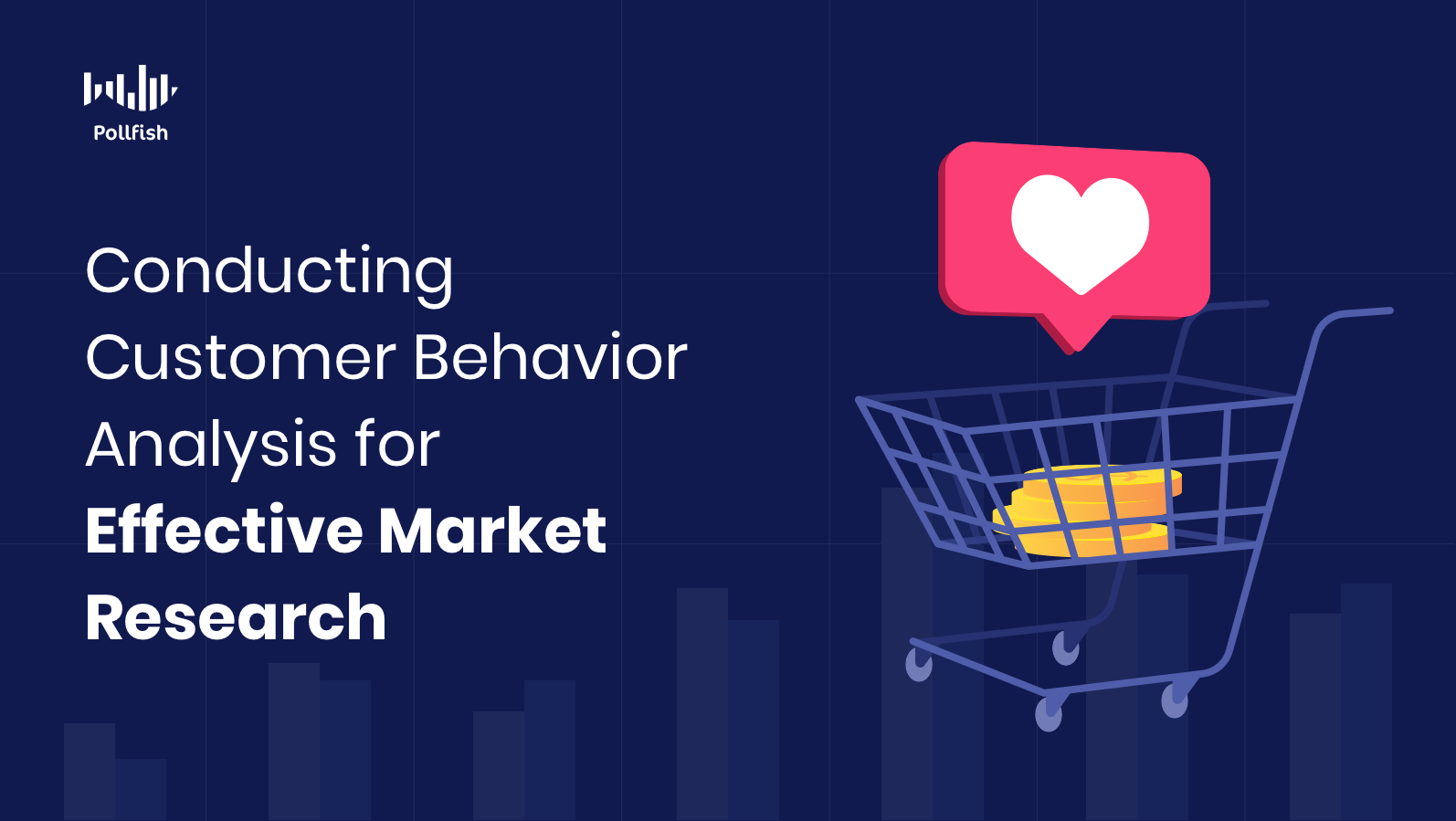
In order to access customers, businesses must conduct a customer behavior analysis. Given that customers are the lifeblood of any business, it is critical to analyze their behavior, as doing so will support any business strategy.
A customer behavior analysis is a kind of analysis that provides a granular evaluation of customer behavior. Specifically, it examines customer behavior in relation to a particular business.
It is especially important to run this analysis, given that customer expectations and needs constantly shift; nevertheless, 76% of customers expect companies to understand their needs. When businesses understand customer behavior, they have a context to their customers’ needs, making them more practical to fulfill.
This article explores customer behavior analysis, its importance, how to conduct it and how the role of survey research in conducting this analysis.
Understanding Customer Behavior Analysis
A customer behavior analysis is a kind of analysis that melds qualitative and quantitative observations of how customers interact with a particular company. It involves studying how customers interact in-store, on a website, social media, apps and other places, both physical and digital.
This analysis examines what influences their customer buying behavior, which includes studying the triggers, motivations and reasons behind their buying choices.
In this behavior analysis, customers are first segmented into customer personas based on their shared characteristics. Then, researchers observe each segment throughout the different stages of their customer journey map. This stage serves as the heart of the analysis, as it requires scrutinizing how the personas interact with a company.
This analysis grants insight into the various variables that may influence a customer segment and customer persona. It allows businesses to understand how customers feel about a company, thus it is a crucial component of brand tracking.
The Importance of Customer Behavior Analysis
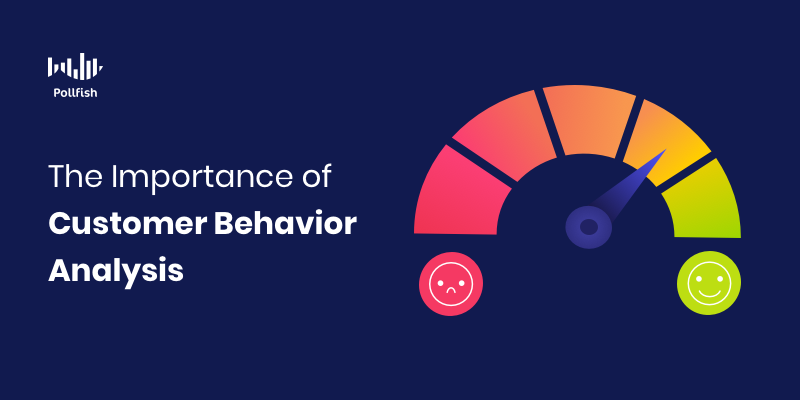
It is important to conduct customer behavior analysis for a number of reasons.
A behavior analysis is a proven method for understanding customers and connecting them to the business. It allows businesses to understand their customers’ priorities, motives and rationalizations behind their decisions.
Given that customers exhibit these thoughts and actions as part of the customer journey, conducting this kind of analysis helps businesses understand how customers feel about their company.
Additionally, a customer behavior analysis allows companies to understand customer habits and motivations. This includes how customers behave in different settings, whether it is digitally or physically.
Without it, market researchers and online store web developers would only have a scant idea of how their customers shop, whether it is on or offline. Conducting it can reveal these multi-environmental habits, also revealing unique or latent patterns.
Businesses can also offer a better shopping experience by nailing down where and how customers face issues. These can involve non-virtual problems, such as poor customer support, along with technical problems, such as slow web pages and functionality problems.
When it comes to the latter, a poor check-out experience may lead customers to abandon their carts prior to purchasing. Additionally, an improper search may deter shoppers from finding their products. These instances lead to site leaves and lack of conversions, therefore casting a blow to revenue. Businesses can avoid these issues and missed opportunities by performing a customer behavior analysis.
Furthermore, businesses can improve their existing marketing campaigns and form new ones from analyzing customer behavior. This will improve both customer retention and acquisition, as brands can tweak campaigns based on studying existing target market members, therefore creating more fitting campaigns for future potential customers.
This analysis reveals recurring patterns on shopping transaction timing, location of purchase, device used for purchases, frequency of buying, favorite products and other behavioral aspects. As such, marketers can better understand customers’ actions and use this information to target their audience more precisely.
Moreover, marketers can use this data to optimize various customer experiences, create more personalized content from the intelligence they gained, create more enticing advertising campaigns and determine the value of different customer segments and personas.
All in all, customer behavior analysis offers a myriad of benefits that can help solve various business needs.
The Use of Surveys in Customer Behavior Analysis
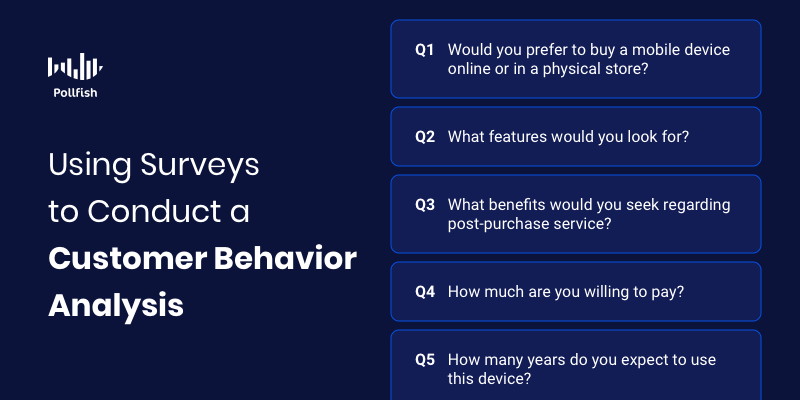
Given the scope of customer behavior, there are various methods and tools to analyze it, from one-on-one calls with customers, to in-store experiences, to digital tools such as experience analytics.
Online surveys are the most potent tool for studying customer behavior, as they allow businesses to study virtually any aspect of customer behavior and ask all of their desired questions.
Surveys offer value in various aspects of performing a customer behavior analysis, such as segmenting customers via market segmentation. This allows businesses to understand the key groups making up their target market and how to serve them more effectively. Additionally, as aforementioned, surveys help businesses form their customer personas, another key practice for targeting an audience.
Surveys allow market researchers to inquire into any customer behavior topic. This way, researchers can detect the presence of certain common behaviors, along with patterns in preferences, actions and inclinations, all of which are crucial factors in a behavioral analysis.
Surveys can provide both qualitative and quantitative market research data for researchers, granting them a holistic view of customer behavior. Thus, surveys do not merely provide a means of analysis but are complementary to various market research campaigns.
A strong survey platform makes it possible and practical to study a vast pool of customer behavior via deployment across thousands of high-traffic websites and apps. Additionally, a platform that offers filtering data for survey results makes it easy to perform an analysis of all the collected data.
How to Conduct a Customer Behavior Analysis
There are several ways to perform such an analysis, including through the use of surveys. The following explains how to conduct a customer behavior analysis through a multi-step approach:
- Segment your target audience. This involves dividing your customers into various groups, or segments, based on shared demographic and psychographic characteristics.
- There is also a wide range of other characteristics to use for segmenting, involving behavioral characteristics such as:
- Web and app activity, preferred media channels and online and offline shopping habits.
- Consider the most valuable segments to your business. You can find them when you calculate customers’ CLV or customer lifetime value, or by performing an RFM analysis.
- There is also a wide range of other characteristics to use for segmenting, involving behavioral characteristics such as:
- Pinpoint the benefits of each segment. Each customer group and persona will choose a particular business in their own unique way. Market researchers should identify what triggers these segments to choose a particular company over another.
- Refer to products, services and experiences, along with external factors that influence buying decisions.
- Consider the different effects on purchasing, such as: did customers buy a product due to its brand? Did they make a convenience purchase? How much did the customer seek to spend? How urgent was their purchase decision?
- Always consider the context of a customer’s behavior and needs during the analysis.
- Conduct survey research. This involves using both the qualitative survey and quantitative survey for a holistic read of your customers' behaviors.
- Additionally, it is critical to perform secondary market research, using external sources of already published data. While this provides useful information, not all or any secondary resource will provide relevant information to your niche and specifically, your customer base.
- After you conduct qualitative and quantitative research, compare the two sets against each other as you discover patterns, habits and other key components of customer behavior.
- Use your analysis findings on a campaign. You can apply your analysis to various campaigns, from content optimization to advertising.
- Use the best delivery channel for each persona.
- Provide personalization to different segments and personas whenever possible.
- Fix any hindrances in the CX (customer experience).
- Nurture the customers throughout their CX.
- Assure any changes won’t adversely affect your customers, as not all will be receptive to change. Conducting surveys can help you determine which customers are less fond of it.
- Analyze the results of any changes you’ve applied to your campaigns. Marketers should always test their results and the same applies to changes made after running a customer behavior analysis.
- Test the effects of your changes with different metrics such as traffic to websites. Advertising spend versus revenue, conversion rates, CLV, customer acquisition cost (CAC) and more.
- Analyzing results ought to be a continual process, giving the vast external influences on customers, such as politics, technology, new products in a niche, etc.
Staying Attuned to Customers
Performing a customer behavior analysis is a crucial task in obtaining a deep understanding of how customers behave in relation to your offerings, experiences and business as a whole. Such an analysis should therefore be ongoing, as even the most loyal customers change from various influences.
Surveys provide a powerful yet practical means for performing a behavioral analysis, given that they can be deployed to the masses, are highly targeted and allow market researchers to delve into any behavioral topic through questions of their choice.
The key is to use an online survey platform that offers these capabilities and more.
Although conducting such an analysis is likely to require several tools and methods, surveys allow researchers to capture insights into all customer behaviors, along with their needs and opinions, as surveys allow researchers to explore any topic and ask about it explicitly and in a custom way.
A strong online survey platform offers capabilities that put survey bias, survey fraud and other low-quality data at bay. Such a platform makes it easy to study customer behavior by extracting data based on precise demographics and psychographics, adding randomization to the sampling process via RDE (random device engagement) and offering several data visualization formats.
Businesses should therefore choose their online survey platform wisely.
How to Find and Obtain a Survey Sample for Accurate Market Research
How to Find and Obtain a Survey Sample for Accurate Market Research

A survey sample is a critical batch of respondents studied in market research campaigns. Given that this group forms the core of any campaign, it needs to be dealt with correctly.
This involves extracting the sample, reaching out to it across various digital properties, analyzing it and moving forward with all the necessary steps to generate effective survey studies.
As such, market researchers and marketers should be acquainted with the various survey sampling methods used to obtain a survey sample and all of its other particulars.
This article provides insights into the survey sample, including how to collect one and proceed with analysis and other crucial next steps.
Defining the Survey Sample
Also called the survey pool, a survey sample is a group of participants who take part in a market research study, specifically, a survey study.
As its name suggests, this sample is derived from the method known as survey sampling, in which researchers extract respondents to represent a population of study. There are various methods and sub-methods involved in survey sampling.
In market research, the survey sample comprises a business’s target market, that is, a portion of a market population that is most willing and likely to purchase from the business. As such, all marketing efforts are directed at this group of the population.
A survey sample does not have to be broad, meaning that it does not necessarily need to study all the members that make up a target market. Instead, it can be composed of a specific segment of a target market.
In order to procure this segment, researchers must perform market segmentation.
Understanding the Various Ways to Obtain a Survey Sample
As aforementioned, there are various ways to acquire a survey sample, one of the most critical preliminary steps in conducting market research techniques.
Acquiring a survey sample includes two major undertakings:
- Deciding on the makeup of the survey sample itself
- Choosing a method to obtain the survey sample
The former involves determining who will take part in the sample and how many respondents to include in the sample. The latter is known as survey sampling and it entails garnering the members of a target population to take part in a survey study.
In regards to the latter, there are two main methods of survey sampling: probability and random sampling. First, you will need to identify the makeup and scope of your survey pool. Then, you can move forward with it by deciding on a survey sampling method to obtain the pool.
The following explains how to carry out the formation of the survey sample.
How to Choose the Makeup of the Survey Sample Itself
In reference to the above section on understanding the ways to obtain a survey sample, the second aspect of acquiring a sample — after choosing between the probability and non-probability sampling methods — is to decide who should be in the survey sample itself and how big it should be.
In order to decide on the makeup of the sampling pool, follow these steps.
- Refer to the purpose of your market research campaign.
- Ask yourself, what are its main themes and variables, along with its appropriate macro markets.
- For example: To learn how to market a new product to middle-aged adults in the US, your target market, or target population is middle-aged adults in the US.
- Decide whether you are looking to study the wider target population, or if it is more convenient for your business to study a particular segment of the population of interest.
- In this case, you would need to conduct market segmentation.
- You can also perform market research to reach the correct target market sample.
- Determine your accuracy requirements. This involves understanding the degree of the risk your survey study will take in terms of receiving answers that do not accurately describe the entire population.
- This is because you won’t be surveying the entire population.
- To determine how closely your answers reflect the views of your studied population, you’ll need to calculate the margin of error.
- Ex: If your margin of error is 4%, that means 4% is added on both sides of the results of your survey sample. So if 70% of your sample likes shopping online, then the results show that 66-74% of your sample actually likes online shopping.
- Your margin of error should be kept under 10% to maintain quality findings.
- Find the proper confidence interval. Also called the confidence level, this metric shows the likelihood of the sample you used matters in your results, as repeated studies would form the same results.
- For example, a 95% confidence level would yield the same results 95% of the time.
- 95% is the most common confidence level used in statistics. The ideal confidence level range is between 90-99%. Anything lower than 90% is not recommended.
- Finally, decide on the most fitting survey sampling method to extract your survey pool.
The Two Main Methods for Obtaining a Survey Sample
Once you’ve identified the makeup of your survey sample, you’ll need to deploy your surveys. To do so, you must decide on a method for obtaining your survey sample. The following explains the two main types of survey sampling methods.
Market researchers ought to understand these methods and all that they entail before initiating any market research campaign. Being versed in these methods will help guide your study.
Probability Sampling
Also called random sampling, this method involves giving every member of a studied population an equal chance of being selected in the survey sample. In order to select the respondents, researchers would use a random process, in which selected participants are presented as unbiased representations of the total population.
Probability sampling has several more complex sub-methods, such as stratified sampling, which involves selecting participants from subgroups of a population, such as those based on age, location, ethnicity, interest, etc. There are various other methods that makeup probability sampling.
Random sampling aims to gain a sample that represents an entire population of study. Therefore, the results of the study must be generalizable to the studied population. As such, this method is viable for quantitative market research, since it is focused on understanding a larger population by studying a much smaller subset.
This kind of sampling is therefore not ideal for qualitative market research, which seeks to elucidate a specific group of people, without generalizing the findings to a larger population.
Non-Probability Sampling
Also referred to as non-random sampling, non-probability sampling acts antithetically to probability sampling, as it does not use random means to select respondents. Thus, the members of a studied population do not have an equal chance of being selected; some of them will have no chance of being selected.
This main sampling method also has several of its own methods, such as convenience sampling, in which participants are selected if they are readily available and willing to participate. For example, if your study requires studying librarians and you only select those in your zip code, as opposed to those across geographic locations.
All procedures that avoid random selections and involve the judgment of the researchers fall under the non-probability sampling method. As such, even an online survey platform — which has a far wider reach than focus groups or one-on-one interviews — is considered a non-probability sampling tool. This is because in such a platform, the survey sample is not derived from every member of the target population. These kinds of platforms may also not rely on random processes.
One of the most powerful forms of non-probability sampling is organic sampling or Random Device Engagement. This method procures respondents organically, that is, it reaches them in their natural digital settings, as opposed to using survey panels, a sampling method that involves pre-recruiting a set of respondents.
RDE polling engages digital users where they are voluntarily; as such, participants join on their own will and can be found on a vast network of publishing websites and apps. Thus, although the respondents aren’t extracted through organic means, RDE still offers a survey sample that joined through organic settings.
How to Proceed with a Survey Sample
After determining the correct people to use for your survey sample, choosing which sampling method is best, along with the correct sub-method to use, launch your survey. Then analyze your initial results by performing a survey data analysis.
This will be the preliminary analysis, as based on your findings, you may need to conduct another survey, either on the same group or on a specific segment of your target market, if your study was aimed at your general target market.
 If you surveyed a segment of your target market, you may need to study another to compare the two. Perhaps some segments are more inclined to generate customer loyalty than others.
If you surveyed a segment of your target market, you may need to study another to compare the two. Perhaps some segments are more inclined to generate customer loyalty than others.
If you discovered a particular behavior from your survey studies that require further studying, consider embarking on experimental research. This will help you prove whether there are correlational factors at play between your variables.
Once you’ve received a valuable share of insights, take action. A valuable amount will differ from company to company and research campaign to research campaign. Consider the findings of your survey studies. If they point to the utility in certain actions, especially if those actions seem prospective for your study or business at large, then take them. The goal of a survey sample is to forge ahead in your market research, which should always be actionable.
Leading the Charge on Your Survey Pool
The survey sample, also referred to as the survey pool, is indispensable for all market research campaigns, as those of the present-day usually rely on survey research. As the core of the survey campaign, the survey sample will determine the accuracy of the entire market research operation.
As such, it must be identified carefully and obtained properly. Aside from the actions to take in regards to these practices, another crucial factor in developing surveys for the correct survey sample is an online survey platform. Such a platform should not simply allow you to create surveys and deploy them, but to reach the correct people, i.e., your survey sample.
A potent online survey platform will allow you to choose the respondents making up your survey pool in the screening or audience section of the survey tool. In this section, you should be able to add and filter the respondents you seek on a variety of categories, including demographics, psychographics and geolocation.
The key is to choose the correct online survey provider.
How to Increase Market Share with Surveys
How to Increase Market Share with Surveys

Companies that want to achieve brand leadership must evaluate and work towards increasing their market share. Businesses with a large market share yield larger profits and brand equity, granting them instant recognition and household name status.
While elevating market share may be the objective of many businesses, it is often difficult to come by, especially for startups and smaller companies. Small businesses are particularly at risk, as 20% of small businesses fail within their first year.
A significant market share prevents business failure, while a shrinking market share can lead to bankruptcy in the worst cases. Thus, it is in the best interest of businesses to assess and attempt to grow their market share, as it will help them achieve recognition and increase profitability.
This article explores the concept of market share, its importance, calculation and how market research, particularly surveys, help increase market share.
Understanding Market Share
Market share refers to the portion of a market that an individual company controls. Specifically, it is the percentage of total sales generated by a particular company in an industry.
This metric is calculated by factoring in a company’s sales over a period of time along with the total sales over the same period. Market share is typically assessed over a year or quarter. (The formula and explanation are in a below section).
This calculation provides a general idea of the size of a company in relation to its market and its competitors. A company with the largest market share is considered a market leader in its industry. These companies tend to be well-established brands with a strong brand equity and consumer loyalty.
Market share shows a business’s monetary standing and its portion of dominance within an industry. As such, it shows how it measures up against other businesses in its market. To increase market share and outperform competitors, a business would need to earn more sales, those that exceed the sales of competitors.
The Importance of Market Share

It is important to keep track of market share in order to understand how a business fares in its overall market and how it performs compared to its competitors. Additionally, growing market share begins with analyzing it.
Businesses of all sizes should aim at scaling their market share, as a higher market share gives companies a competitive advantage. This is because companies with higher shares yield higher buying power, allowing them to save money by receiving better prices from their vendors.
This is made possible by making larger order volumes, something businesses with high market shares engage in, as larger market shares reveal a higher demand for their products or services.
As such, an increased market share works in parallel with larger production, and greater production lessens a company’s cost of producing an individual product. This is due to the economies of sale.
Additionally, the market share metric is a measure of market competitiveness, allowing business owners and executives to forecast market growth and reduction. It indicates whether a business is poised for success or needs to strategize more on avoiding market declines.
It allows businesses to gauge their market potential and focus on improving their standing. Moreover, it is a critical measurement to be used in tandem with studying customer behavior, as it places it in perspective with a business’s market performance.
When businesses increase their market share, they essentially wield a larger slice of the market; a high-performing business will see increases in its market share quicker than its competitors. It is critical to mark down changes to a market share — these include both changes in a business’s own market share and those of its competitors.
This is because, in stable markets, changes in share distribution can distort the well-balanced market forces. In growth markets, however, changes are expected and are less consequential.
Despite the dynamics of a market, increasing market share is crucial for businesses to grow their company. Thus, a larger percentage of the market yields higher sales and revenue.
How to Calculate Market Share
This metric follows a fairly simple calculation. Market share is calculated with only two variables: a company’s sales within a certain time period and the total sales within an industry during that same time period.
To calculate market share, you need to divide a company’s total sales over a specific time period, such as a quarter, by the total sales of its industry within that period. The result is your market share for that time period.
The Market Share Formula
The following displays the simple calculation of the formula:
Market share (MS) = Total sales (S) / Total industry revenue (R) X 100
The following is an example of a business’s market share for one year:
S= 900,000
R= 100,000,000
MS= 900,000 / 100,000,000 = 0.009
MS= 0.009 x 100 = 0.9%
MS= 0.9%
However, businesses can also calculate their relative market share, the measure of a business’s share in comparison to a specific market competitor or market leader. In this case, you would need to have measured your market share already, as it is one of the variables.
Divide your market share by that of the relevant rival. The formula is as follows:
Relative Market share (RMS) = Individual market share (MS) / Largest industry market share (LMS) X 100
How to Grow Your Market Share
Growing a business’s market share relies on a multitude of factors and strategies. Business owners and marketers must apply all of these methods and more to successfully increase their market share.
These methods also help businesses improve across various functions, making them useful contributors to overall business success.
Marketing and branding
Marketing and branding campaigns help businesses improve on a wealth of KPIs. These functions drive demand, awareness and grow a digital following. Branding is one of the many branches of marketing and it is essential for long-term success.
Reduced prices
Price reductions and their various offshoots (promotions, holiday specials, etc.) have long been trusted methods to draw more sales. This allows businesses to beat the prices their competitors offer, luring in new customers before using regular prices again.
Nurturing and Retention
Nurturing customers leads to customer retention, as it allows businesses to be fresh on the minds of their target market. There are numerous ways to do this, such as via email marketing, newsletters, a content subscription, social media, ads and more, such as follow-up calls. This creates relationships with customers, the kinds that nurture them to continue patronizing the company — thus helping raise its market share.
New Features, Products and Services
Creating new offerings helps a brand stay relevant and opens the door for more revenue and sales pools. Many major companies profit off of their innovation, such as Apple, which annually offers new products and product upgrades.
Acquisition
Acquiring the competition not only removes a competitor as a threat to a business, but also gives a business all of the acquired company’s sales, revenue and shares. Mergers and acquisitions grant businesses a major growth spurt and all the assets from its acquired company, directly increasing their market share.
How Surveys Help Increase Market Share

Surveys are a prominent market research method, especially the online survey variety, which connects businesses with the masses, including with those in their target market.
Surveys allow businesses to access the minds of their customers, showing them how to better serve and market to their target market. Surveys also allow companies to uncover the makeup of their target market via market segmentation and identifying customer personas.
Studying the needs, desires, opinions, sentiments and aversions of your target market is an absolute necessity for businesses. In fact, 14% of businesses fail due to not paying attention to their customers’ needs. Those that do are more equipped to acquire new customers and retain existing ones.
Surveys allow brands to be data-driven, providing a tried and true method for obtaining data for decision-making.
Surveys also have the capability to influence customers’ purchasing decisions. This is especially true if a brand inserts its name and offerings into its survey. Or, it can pinpoint customer pain points and the lack of other companies’ means of correcting them.
Surveys enable businesses to ask any questions they seek, thereby bringing them answers they wouldn’t otherwise find from conducting secondary research alone. They are superior to other primary research methods, as they are completely anonymous and lessen the pressure of respondents to answer in a particular way.
As such, survey research makes businesses well-attuned to their customers, allowing them to market to, nurture and communicate with them more effectively. In turn, their performance will improve, raising revenue and therefore their market share.
Netting a Larger Slice of the Market
Businesses of all sizes must assess and work towards increasing their market share, as it represents the portion of a market that an individual company controls in relation to the overall market.
It helps businesses understand their market standing in comparison to their competitors and predict growth and declines. A larger market share lets businesses increase their capacity and efficiency.
In order to evaluate and grow market share, businesses ought to conduct survey research. However, they must use the correct online survey software.
A strong online survey platform offers a plethora of capabilities and extracts only the most quality data.
Such a platform should offer full customization of the screener and questionnaire, deploy the survey to targeted individuals in a massive publisher network, offer filtering data after the survey completes all of its quotas and use artificial intelligence to perform quality checks that remove poor quality data.
This kind of platform provides the most useful customer data, allowing a business to make headway to its market share.
Using Survey Research to Unlock Cultural Trends
Using Survey Research to Unlock Cultural Trends
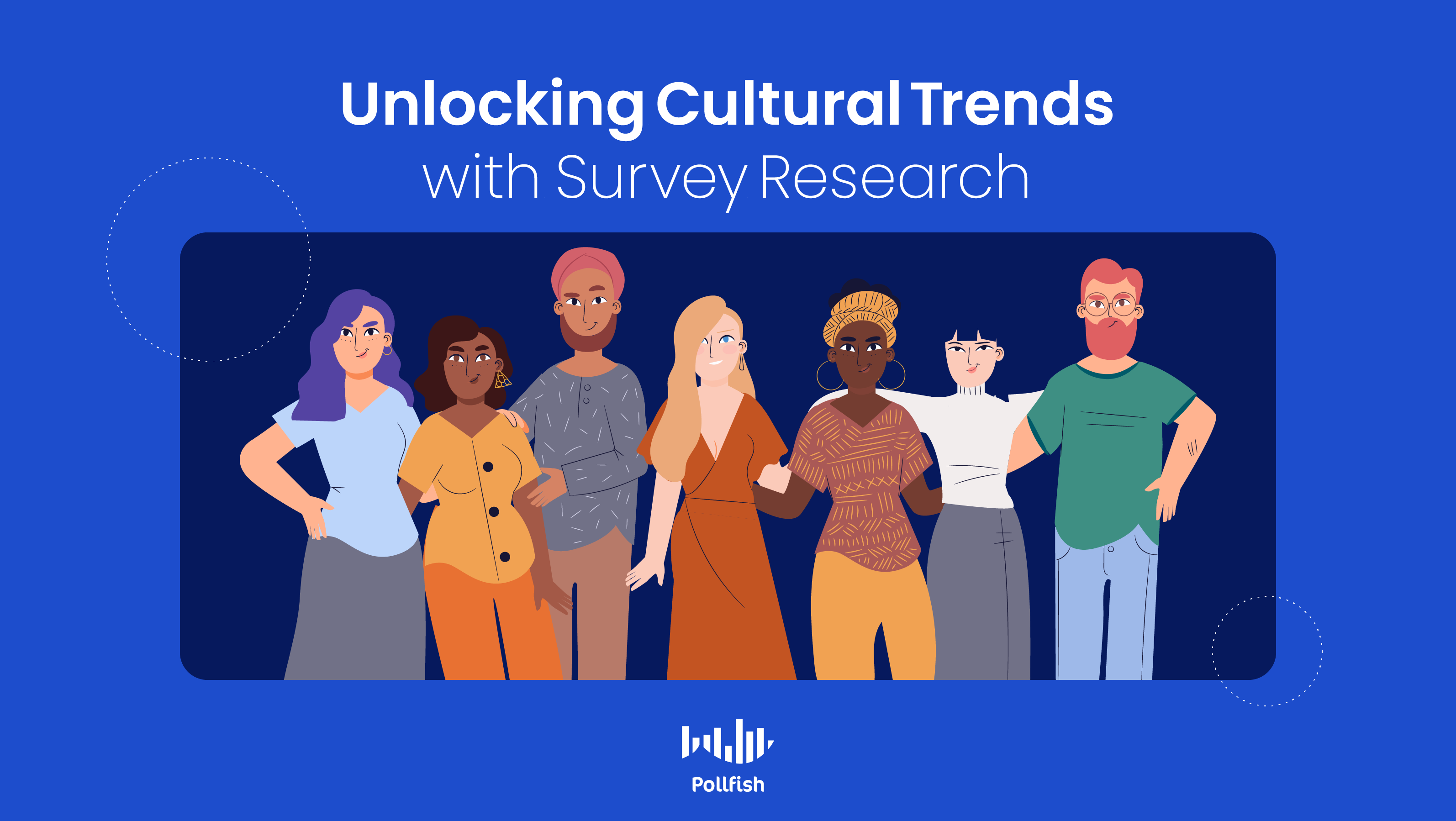
In order to stay adept at serving customers, brands must be attuned to cultural trends, whether they’re operating domestically only or marketing to customers abroad.
Our Global Customer Expectations poll revealed that almost a quarter of global customers seek brands that are more sensitive to the cultural aspects of their country.
Another supporting study found that brand involvement in cultural trends makes up a full 25 percent of a customers’ purchase decision. Evidently, brands have a stake in cultural involvement when it comes to satisfying their customers.
Unlike some of the more static aspects of marketing, cultural trends are, by nature, inclined to shift and fluctuate. Thus, the challenge becomes not merely discovering cultural trends but assuring their relevance and showing cultural deference.
This article delves into cultural trends, the need for businesses to be culturally competent and relevant, how surveys uncover various cultural trends and how to set up a survey to extract this information.
Understanding Cultural Trends
Cultural trends refer to popularized alterations and tendencies in culture, whether they are material or nonmaterial. These involve emerging or continuous behaviors, items and the relations of both. For example, product use; some trends involve using products in a particular way or for a particular act.
Cultural trends can also specifically apply to the dominant or emerging cultural aspects present among different cultures. This is a matter of concern for businesses that operate both internationally and domestically, as customers expect businesses to understand cultural matters that pertain to their country — as our survey found — along with others.
For example, a study by Salesforce found that 66% of customers expect companies to understand their unique needs and expectations, yet 66% also say that they are treated like numbers. Additionally, 52% of customers expect offers to always be personalized.
Understanding cultural differences and trends is crucial in each case. In regards to the former, understanding cultural practices and other concerns is crucial to make customers feel distinguished and as more than just another number being marketed to.
Regarding the latter, personalization cannot be fully achieved without paying attention to cultural matters. In fact, companies may incur issues when trying to personalize, by not taking into account cultural differences.
Businesses must also take heed to the cultural trends present within their country, as it is a means of staying relevant. Some cultural trends align with certain values, which is crucial to include in marketing campaigns. This is because 71% of customers prefer buying from companies aligned with their values.
Understanding cultural trends is key for market research, especially if a brand uses its name in its research; it is also important for a wide breadth of marketing campaigns.
The Importance of Cultural Trends
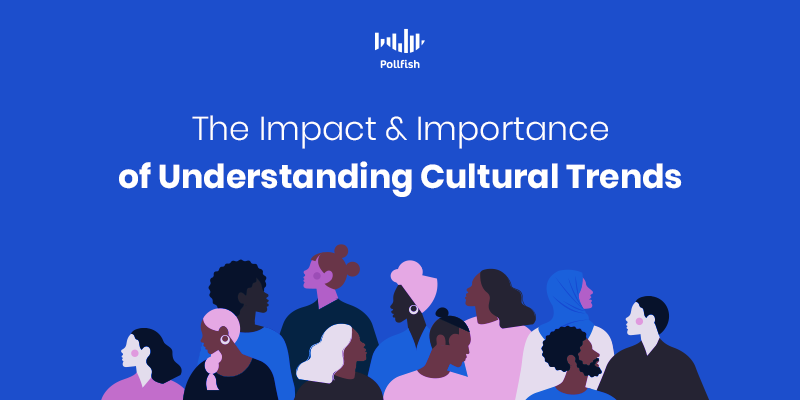
To piggyback off of the previous section, understanding cultural trends is a must for various reasons. The two main reasons deal with domestic and international customers. However, they also apply to dealing with employees, vendors and partners.
On the international front, few businesses can evade the need to deal with foreign clients, customers and employees. Given that the world is globalized and global markets open new opportunities, businesses would be at a disadvantage not to branch out into new geographic markets.
In order to properly cater to the international market, businesses must be acquainted with cultural trends across geographies, especially those that pertain to specific countries.
Cultural change is broader than social change, although it can include it in its sphere of influence. As such, societies and their markets are the results of culture. It is a culture that sets boundaries, limits and dictates what is acceptable or not. Thus, businesses must be in tune with the culture of the market they wish to pursue.
Understanding cultural trends is the gateway into cultural competence, the ability to effectively interact, work, and develop meaningful relationships with people from various cultural backgrounds.
Cultural competence allows brands to ease into different geographic markets, as it makes global customers feel understood and heard, a key tactic to ward off making them feel like just another number.
Understanding cultural trends also helps businesses avoid cultural misunderstandings, the kinds that directly cause businesses to lose customers and tarnish their reputation. This can get to a bad enough point in which a business’s harmless misunderstanding makes the news, a blow to brand equity and reputation.
Finally, being culturally competent is necessary for conducting business domestically, as customers are more likely to buy from brands that incorporate timely cultural aspects into their marketing and business at large (as proven in the intro).
Incorporating cultural trends domestically posits a business as more culturally savvy than its competitors. Additionally, it speaks directly to some of the thoughts occupying customer’s minds.
Moreover, the US and many other countries have significant immigrant populations; thus it is imminent for companies to be in contact with people of other cultural backgrounds, whether they are customers, employees, partners, vendors or clients. Thus, it is key to be in the know of all the cultural trends of your target market.
How Surveys Help Discover All Kinds of Cultural Trends
Surveys are a tool that opens many doors into the minds of customers, and customer satisfaction is a prominent objective to keep any business afloat.
Firstly, surveys define a business’s clientele; this is done via market segmentation, in which market researchers granularly define their target market by segmenting into different groups. This helps businesses learn the demographics of their most valuable customers.
Through this practice, businesses uncover the ethnicities, cultures and national backgrounds of their targeted customer segments. This allows businesses to zero in on particular cultural trends: those that are most relevant to the segments of their target market, specifically the most valuable segments.
Furthermore, surveys allow brands to delve into virtually any topic of their choice and understand it at an in-depth level. Thus, they can do so by creating surveys that delve into their target market’s cultural trends.
Surveys, especially the online variety, provide the ease of deploying questionnaires to a business’s intended audience. Most conveniently, online surveys are completely anonymous, so respondents can freely provide answers on all cultural matters, even those that are more sensitive in nature.
Businesses can cover various cultural matters in just one survey, though longer surveys should provide survey incentives to guarantee participation. Businesses can also set up survey campaigns that include multiple smaller-length surveys that cover various topics within cultural considerations.
Surveys have the power to generate both quantitative and qualitative market research, depending on how the questions are set up. Multiple-choice questions lend themselves to quantitative data, while open-ended questions allow businesses to gain qualitative data unique to each survey respondent.
Either way, businesses can gain both kinds of data within just one survey. To do so, they can ask a multiple-choice question and follow it up with an open-ended question.
Survey Questions that Unlock Cultural Trends

The questionnaire is the heart of a survey; therefore, brands must arrange it strategically to set their survey up for success.
They should also target respondents differently per country in the screening portion of the survey. After choosing the customer segments to target, researchers need to create their questionnaire accordingly.
Because all countries, even those that appear to be culturally similar, have distinct cultures, market researchers should focus on specific questions per country. However, before veering into the specific, there are certain general questions that researchers should begin with as a best practice.
The following provides question examples on the preliminary questions market researchers can use in their cultural trends survey before delving deeper:
- What is the biggest cultural change you’ve seen [country name] undergo?
- Multiple-choice and open-ended answers
- How do you feel about [a cultural event, major recent occurrence, trend observed via secondary research] ?
- Scaled and open-ended answers
- Which brands do you use for [a particular need]?
- Multiple-choice, multiple-selection answers
- Do some research on the brands from a particular country
- What would be considered rude coming from a company in your country?
- open-ended answer
- What are some of the biggest trends in [your niche] in your country?
- Multiple-choice and open-ended answers
Being In Tune With All Customers
A lack of cultural awareness has grave costs on businesses. That’s why virtually all businesses must be culturally aware within their domestic and international markets. The latter is especially important in the age of the internet, where global customers may discover a brand digitally, therefore opening the doors for businesses to venture into global markets.
While surveys are a convenient method to uncover cultural trends and differences, they are only as useful as the online survey platform that administers them. A strong online survey platform must be able to facilitate all stages of the survey process: from the screener, to the questionnaire, to deployment and finally, filtering data after the survey completes all of its quotas. Additionally, a strong survey software uses artificial intelligence to perform quality checks that remove gibberish answers, flatlining and other poor data to ensure the highest quality of customer data.
Businesses should opt for such a platform to not simply obtain cultural trends information, but to engage in a valuable market research campaign.
Understanding Customer Value and How Businesses Can Generate It with Surveys
Understanding Customer Value and How Businesses Can Generate It with Surveys
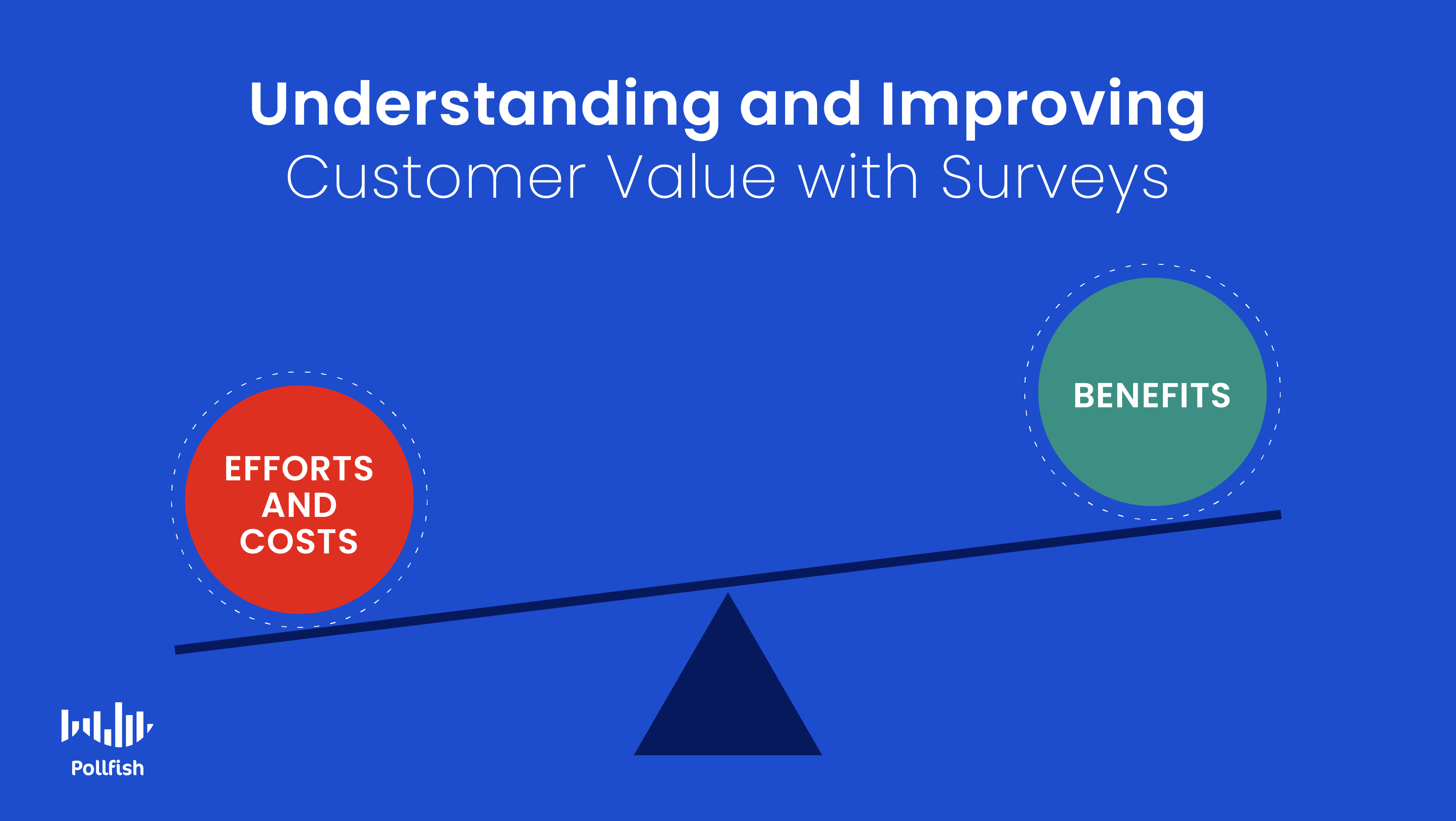
Customer value is a key aspect for acquiring, developing and retaining customers. Businesses would be remiss not to work on improving it to sustain profitable customer relationships.
Contrary to its name, it does not signify the value that a customer brings to a business — which is not to say that customers don’t carry value. Rather, customer value denotes the satisfaction a customer experiences or expects to experience by taking an action relative to the cost of that action.
Businesses must provide this value, as over 65% of customers globally believe it is very important for businesses to understand their unique needs and expectations. When a business properly serves its target market, then its members derive a higher customer value.
In turn, this makes a business more competitive and better positioned to develop customer satisfaction and build customer loyalty.
This article explains the concept of customer value, its importance, how to calculate it, how surveys can improve it and more.
Understanding Customer Value
Also called customer-perceived value, this concept is defined by the perception of what a product or service is worth to a customer versus its possible alternatives.
More specifically, it entails the benefits a customer derives from a service or product in relation to the customer’s costs, which include all the efforts and difficulties they face when obtaining or using a product or service.
In short, this measurement explains whether a customer feels they received benefits over the price that they paid.
In this regard, “paying” does not simply refer to prices such as one-time and subscription costs, fees, interest, etc. Instead, it also includes non-price aspects, such as providing their effort, energy, time, data and other inconveniences.
In addition, payments do not necessarily refer to purchases; they can also mean store visits, sign-ups, content downloads and more.
The benefits in customer value denote the advantages or quality of a product, service, image and the brand equity of a company, along with a good customer experience (CX), values, the success a customer experiences from using a product and so on.
Businesses can heighten their customer value when they augment their core competencies and other drivers of value to better serve all customers’ needs and concerns.
The Importance of Customer Value
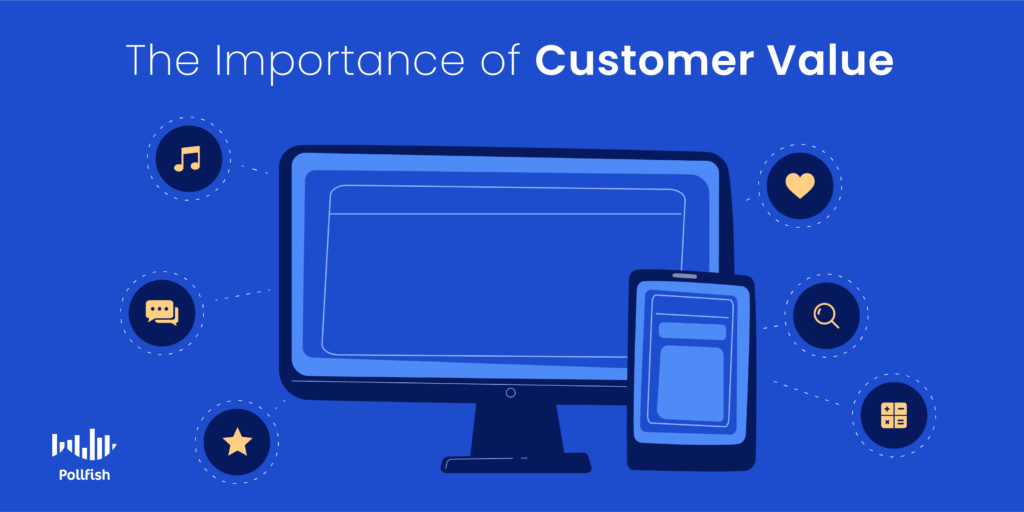
Customer value is important for businesses for many reasons.
Firstly, customer value increases both the customer experience and customer satisfaction. CX plays a major role in the long-term success of brands, as 74% of customers are likely to buy based on customer experience alone. Experience-driven businesses also see a 1.5 times higher YoY growth in repeat purchases and customer retention, a necessity for maintaining a business’s customer base.
The reverse also occurs, as a good customer experience creates customer value.
As for customer satisfaction, it is especially important for a business, as unhappy customers churn, while satisfied customers stay and are far more likely to become repeat customers. Thus, satisfaction drives loyalty, thereby upholding customer retention. Customer value is largely involved with satisfaction, as satisfied customers drive some sort of value, while dissatisfied customers either don’t or gain very little from their transactions and engagements with a business.
Customer value also forges customer advocacy, in which the customers themselves act as marketers for a company. Customer advocates recommend the companies that bring them value, thereby spreading brand awareness, fostering a positive brand image and essentially providing free marketing services. Customer advocates spread their messages across social media, review websites, forums, blogs (if they have them) and also produce word-of-mouth marketing. This can attract many new leads and conversions.
Additionally, customer value steers sales forward, as it creates a sense of urgency for customers, prompting them to not simply buy but to buy sooner. By forming timeframes for key value-building benefits to the customers, such as increased efficiency, lower downtime, better quality, and many more value points, customers will be much more drawn to purchase from a business in a timely manner. In turn, sales workers can close sales quicker.
Finally, while it may seem to be a stretch, creating customer value contributes to a business’s market share — the percentage of a total market a business controls for its products and services. A higher market share allows businesses to operate on a greater scale and increase their profitability. This occurs when businesses provide as much customer value as possible, such as pricing convenience, useful products and many other factors.
How to Calculate Customer Value
Although customer value includes intangible items in addition to tangible ones, businesses can still measure it to understand the value their customers derive from their business. First, businesses must consider all the factors that make up the two main variables in customer value: benefits and costs.
When compiling all of these factors, businesses must identify the most relevant ones in relation to their business and for their customers. The reason behind this is evident, given that businesses have different value propositions, offerings, prices and so on.
Although the calculation for customer value is simple, the many factors behind its two variables render this calculation more of a rough estimate, than a hard and fast metric.
The following lays out the various components of customer benefits and costs:
Total Customer Benefits:
- Product benefit
- the problem a product solves
- ease of onboarding
- Service benefit
- service convenience
- Experience benefit
- ease of use
- Personal benefit
- social status
- Image/branding benefit
- brand reputation
Total Customer Costs:
- Monetary costs
- Tangible
- The price of a product or service
- Installation or onboarding costs
- Renewal costs
- Tangible
- Time costs
- Intangible
- Time invested in buying a product or service
- Time invested in learning how to use a product
- Intangible
- Energy costs
- Tangible
- Installation or onboarding costs
- Maintenance costs
- The cost of accessing your product or service
- Renewal costs
- Intangible
- Time spent understanding how your product or service works
- Physical commitment
- Tangible
- Psychic/emotional costs
- Tangible
- The cost of accessing your product or service
- The cost of using a service/product with issues
- Intangible
- A poor customer experience
- Physical or emotional stress induced from buying or installing your product
- A poor brand reputation
- Tangible
Businesses must bear in mind that because this calculation includes tangible and intangible elements, the customer value formula won't look like a typical mathematic calculation.
You'll need to specify how much benefits are worth in comparison to the costs customers incur, such as time investment, emotional stress, and more.
Customer value is also going to vary depending on the customer segments you analyze. Since each segment, customer persona and individual customer is different, they’ll have particular needs, expectations and goals.
As such, they’ll have customer values, along with different standards of good and poor value. Businesses should therefore conduct market segmentation, identify personas and calculate the customer value for each segment and persona.
The Customer Value Formula
After you consider all the possible benefits and costs associated with your business or particular product or service, and have narrowed down the most relevant, you’ll need to plug them into the customer value formula.
Use the following formula:
(Total Customer Benefits - Total Customer Costs) = Customer Value
(B - C = CV)
How Surveys Help Improve Customer Value
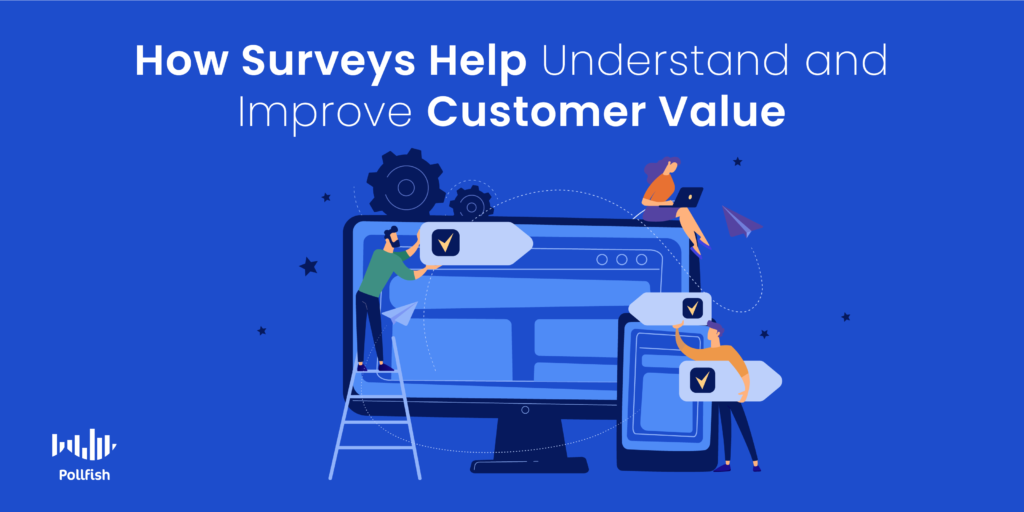
Online surveys provide a method that goes far beyond understanding a target market, or any group of customers. It can significantly improve customer value. Here’s why:
Brands should consider that when they sell a product, the utility of that product usually doesn’t change among customers. However, although its functionality remains the same, customer value will waver, as customers find value in different aspects of a product.
Surveys give businesses a firsthand approach of understanding what they consider valuable and what tarnishes that value for them. Adding to this, surveys can be set up in a number of ways, allowing business to both measure and gain specific customer data.
With online surveys, businesses can segment their customers and identify personas, as surveys are potent tools for market segmentation. In addition, online surveys grant businesses the ability to target their most loyal customer group.
Thus, surveying allows them to understand the makeup of their target market more precisely and study the most valuable subsets of customers.
There are also numerous kinds of customer satisfaction surveys, such as the net promoter score, or NPS survey and the customer effort score, or CES survey. The CES survey is particularly relevant to customer value, as it measures customer effort, one of the costs and variables of customer value.
Businesses should also consider that customer needs change throughout the customer journey and especially during a customer lifecycle. The customer journey includes pre-sales purchase intent, the browsing, the actual purchase, the installation, the use of a product or service and post-sales events. Thus, what they prioritize in terms of value is constantly changing.
Surveys allow companies to keep track of those changes, whether it is via brand tracking, brand visibility, changes in customer loyalty and more. Surveys can be deployed through various stages in the sales process making it easy to detect changes and consistencies in what customers perceive to be valuable about a business and its offerings.
Additionally, surveys allow businesses to evaluate how different customer segments feel about their pricing in a simple way. This is important to customer value, given that price is one of the major costs associated with customer value and a general customer pain point. All answers remain anonymous, which allows customers to be honest about how they feel about prices.
Forging Value Across All Offerings
In summary, businesses ought to pay careful attention to their customer value, as it dictates how customers perceive a brand in terms of its value to them. It is evident that businesses with low customer value will inevitably lose customers, while those with high customer value will retain and acquire customers.
Online surveys provide a quick and efficient way for businesses to understand and improve their customer value, as surveys gain insights on all the factors and variables of this notion. They can show where businesses are lacking, how they can improve and most importantly, what it is specifically that customers want and need.
However, not all online survey platforms offer the same functionalities and efficiencies. Businesses must therefore invest in a strong online survey platform, one that makes it easy to create and deploy surveys.
Additionally, they should opt for providers that offer high-quality data, such as RDE (random device engagement sampling) to net respondents in their natural digital habitats in a completely randomized way, as well as include artificial intelligence that performs quality checks that ensure the highest quality of customer data.
When an online survey provider offers all of these functionalities and customer service around the clock, businesses are poised to gain valuable insights on customer value, raise it and are generally in good hands for all other customer data needs.
Understanding the Customer Churn Rate and Using Surveys to Lower It
Understanding the Customer Churn Rate and Using Surveys to Lower It

The customer churn rate is a crucial metric that all businesses must measure, as customer churn is a grim reality that businesses contend with regularly. In fact, two-thirds of companies have a customer churn rate above 5%.
Also referred to as customer attrition, defection or turnover, this metric gauges the unfavorable aspect of the loss of business with customers, users, vendors, revenue, or other factors within a period of time.
Commonly used in SaaS market research, it is used to measure the percentage of customers who unsubscribe from a SaaS product in a given period of time. However, this metric is crucial to measure in all industries.
This rate ought to be kept low, as churn usually indicates customer dissatisfaction or the availability of affordable alternatives. This is hugely problematic, as the customer is king; 43% of customers spend more money on brands they're loyal to. Additionally, acquiring a new customer costs 5 times more than retaining an existing customer. Thus, businesses should retain their loyal customers.
This article expounds on the customer churn rate, its importance, its average across various industries, its calculation and how surveys can lower it.
Understanding the Customer Churn Rate
As its name suggests, this rate is a calculation of customer churn. Before diving into the metric, businesses should understand the meaning of customer churn.
Customer churn refers to the number of customers or subscribers who stop using a service during a given time period. There are a number of ways that customer churn affects a business, depending on its nature. These include:
- An account closure
- A subscription cancellation
- A non-renewal of a contract or service agreement
- A consumer switching to another service provider
- The cancellation of a contract midway through it or before completion
The customer churn rate (CCR) is therefore a metric that calculates the total number of customers a business has lost during a specific period. Therefore, it is the antithesis of the customer retention rate.
The customer churn rate is typically used to measure churn in businesses that run on a contractual or subscription-based product or service offering. As such, this term is chiefly associated with companies that operate on a subscription basis, such as SaaS companies.
referred to as the proportion of contractual (or subscribed) customers who terminate their contractual relationships/subscriptions with a company in a given timeframe. In this context, the term is primarily associated with companies operating on a subscription basis.
The Importance of the Customer Churn Rate
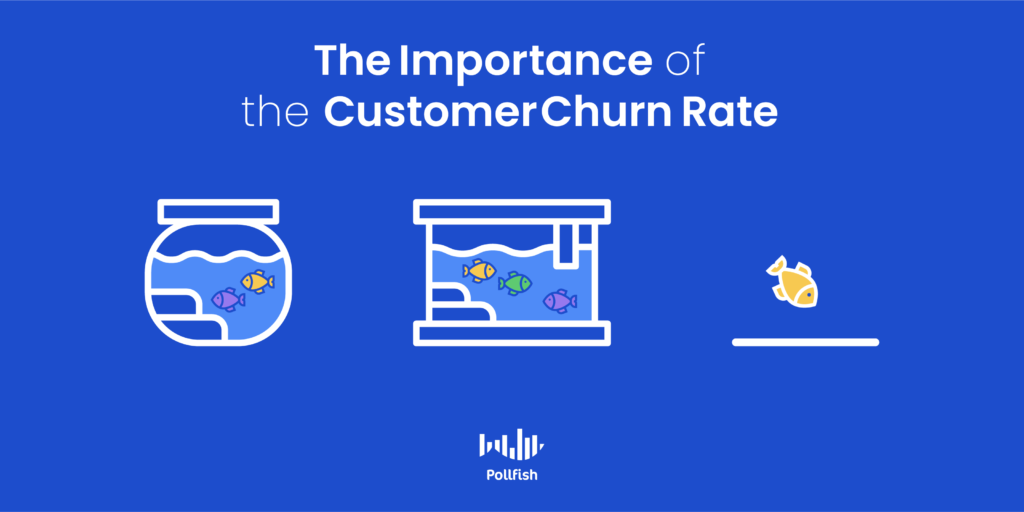
Businesses should measure their customer churn rate at regular intervals, as it is an important metric.
Firstly, its indication of lost customers directly ties into lost revenue. When a company loses customers, it negatively affects its bottom line. In this way, a high churn limits a business’s growth potential. Additionally, a significant churn rate always incurs financial difficulties of some degree.
Another reason it is so important to study and improve customer churn is that it is far more expensive to acquire new customers than it is to retain existing ones. In fact, acquiring a new customer costs 5 times more than retaining an existing one. As such, a business’s customer acquisition cost (CAC) is going to be more expensive than its customer retention rate (CRR).
Therefore, when a business loses existing customers, it will have to grapple with both the loss of revenue and business opportunities, coupled with the need to spend more on acquiring customers to make up for those that have churned.
As such, businesses must rein in their customer churn rate — and in order to do so, they have to keep track of it.
Studying this rate also involves keeping tabs on the competition, another critical area of maintaining business success. This is because the CCR can increase when competitors launch new and/or less expensive products, which may entice customers to churn and switch to them.
This dampens customer loyalty for obvious reasons and for some customers, can be a permanent switch to another brand. The ability to predict the churn rate is necessary for a company’s long-term success. Thus, businesses should gauge their churn rate and control it whenever possible.
How to Calculate the Customer Churn Rate
There are multiple ways to calculate the customer churn rate. This metric is typically presented as a percentage of either lost revenue or customers lost within a period of time. The following explains the CCR calculation:
To calculate a company's churn rate, first, you must choose a period of time to evaluate and identify the following values:
- The number of customers at the start of a period (X)
- The number of customers lost during the period (Y)
Then, use the following churn rate formula to determine your customer churn rate (Z), expressed as a percentage.
Customer Churn Rate Formula
CCR = (Y / X) x 100
CCR = (number customers churned in a period / number of customers at the beginning of the period) X 100
For example, if a business had 200 existing customers at the start of Q3 and lost 20 customers by the end of Q3, it would calculator its churn rate as such:
CCR = (20/200) x 100
CRR = 0.1 x 100
CRR = 10%
This means that this business has a quarterly customer churn rate of 10% for Q3.
Aside from the number of lost customers, there are other churn metrics to plug into the customer churn rate formula. Whether or not these metrics are worth using to calculate the CCR is completely up to the business in question. It will depend on the nature of the business and its performance metrics needs.
Other churn metrics that businesses can use include the following:
- recurring revenue lost
- percentage of customers lost during a specific period
- decreased engagement product engagement
- percentage of revenue lost
- other variables specific to their product and business.
The more granular a company is with its customer churn analysis, the more effective it can be when working to reduce the churn rate and keep its customers.
Ideal Versus Poor Customer Churn Rate Benchmarks
All businesses undergo churn, even those that are new and/or are experiencing a solid subscription rate with no current turnover.
How can businesses distinguish between a good and bad churn rate? There are certain existing benchmarks for this. The most ideal, but unrealistic churn rate is 0%, as no business profits when a customer churns.
Given that it is virtually impossible to maintain a 0% churn rate, there are certain practical benchmarks that businesses can aim for. The following lists both ideal and poor CRR benchmarks that businesses ought to know:
- The ideal churn rate is 5-7%.
- This is considered the proper rate for mature and well-established SaaS companies that target enterprises.
- For early-stage businesses, the monthly churn should be closer to 5%.
- A churn rate above 10% is a critical warning that a business is poorly faring in customer retention.
- It signifies the need to change the customer experience (CX).
- A high CCR is over 10%, signifying that a business is operating at an unsustainable rate.
- It usually means that marketing efforts/ resources are used for acquiring customers rather than retaining them.
- When a business has a high churn rate, it must examine how it forms and fosters its customer relationships.
The Customer Churn Rate Across Industries
The CCR varies across industries and is highly likely to vary from one company to the next. Businesses should have an overview of how the churn rate fares in their industry and others. The following lists the average customer churn rate across several major industries:
- General retail: 24%
- Online retail: 22%
- Financial: 25%
- Telecommunications: 21%
- Travel: 18%
- Big box electronics: 11%
- Cable: 25%
- SaaS: 4.79%
How Surveys Can Lower Customer Churn Rate
Survey research can be used for a variety of purposes, which include lowering this unfortunate metric. This is because reinforcing strong business relationships with customers is a must in order to decrease the CCR. The most potent way to achieve this goal is by understanding your target market. Surveys allow businesses to do so in a quick and efficient manner.
Surveys allow businesses to examine their customers on an in-depth level, as surveys provide them with anonymity and speed, unlike survey panels and focus groups, which are not anonymous and are typically more time-consuming.
Given that surveys can address a wide range of topics, from customer satisfaction, to customer aversions, to customer buying behavior, brands can gain a wide swath of insights that support various campaigns.
Whether a business seeks to adjust its pricing strategy, partake in customer development before releasing a new product or improve its brand visibility, surveys provide the strongest means for obtaining customer feedback and insights.
Essentially, surveys allow businesses to understand their customers in relation to numerous business topics and concerns, while also providing them the opportunity to improve their strategies across functions, such as marketing, advertising and beyond. When businesses are in lockstep with their customers, they are far less likely to disappoint them.
Thus, businesses that know how to cater to their customers are poised to satisfy and delight them, thereby lowering their customer churn.
Using the Best Online Survey Platform to Reduce Churn

Customer churn can occur within even the most loyal of customers, especially in a highly competitive landscape. Understanding what causes formerly loyal customers to abandon ship is much-needed to sustain business growth.
While survey research is crucial, all online survey platforms are not identical in function, interfaces, data quality and ease of use. A strong online survey tool ought to excel in all regards and more.
For example, a useful online survey platform should incorporate RDE (random device engagement sampling) in order to capture respondents in their natural digital habitats and in a completely randomized manner, as well as include artificial intelligence that performs quality checks to ensure the highest quality of customer data.
Businesses should choose their survey software wisely, should they seek to lower their churn rate and improve on many other business fronts.

